来自ASLA对gooood的分享。
Curbing Sediment: A Proof of Concept| Halina Steiner + Ryan Winston
项目陈述
Project Statement
路缘石的设计十分简单,它通常由混凝土构成,通过水沟与人行道之间的6英寸的坡度变化来划分行人和车辆空间。路缘石本身具有输送雨水的功能,会加速水(和污染物)从街道流向我们的水道。
各类污染物,例如沉积物、草坪肥料的营养物质、细菌、杀虫剂、金属和石油副产品,都存在于雨水中。污染物积聚于路面,并在暴雨发生时释放出来,通过混凝土路缘石、排水沟和集水坪系统被带入暴雨排水管,经由下水道沉积至水道中,且往往没有经过任何处理。一旦污染物进入水道,它们将会给生态系统和水质带来影响。如何利用细化元素(如路缘石)的设计标准来产生更大的系统性影响?
这一名为“遏制沉积物”的研究项目对混凝土路边和集水坪的设计标准提出了挑战。该研究试图通过改变路缘石和集水坪的表面来减少雨水径流速度,并在进入水道之前收集道路沉积物,从而替代原先的标准。
The design of a curb is straightforward. Often formed of concrete, it delineates pedestrian and vehicular space via a 6” grade change from gutter to sidewalk. The curb itself provides a conveyance of stormwater, facilitating the movement of water – and pollutants – from the street into our waterways.
Pollutants such as sediment, nutrients from lawn fertilizers, bacteria, pesticides, metals, and petroleum by-products are all present in stormwater. Pollutants accumulate on the road surface and are released during storm events, carried to storm drains via a system of concrete curbs, gutters, and aprons, and deposited into waterways by sewers, often without treatment. Once pollutants enter the waterways they impact the ecosystem and affect water quality. How can discrete standards – like a curb – be leveraged to have larger systemic impacts?
This research project, Curbing Sediment, challenges the design standard of the concrete curb and apron. Curbing Sediment investigates alternatives to this standard via alterations on the curb and apron face to reduce stormwater runoff velocity and collect roadway sediment before it enters waterways.

▲现有的以及设计后的路缘石、水沟和集水坪:现有的道路条件会让首次冲刷的有毒物质进入雨水沟。新的设计可以在污染物进入雨水沟和水道之前就将其拦截。Current and Proposed Curb, Gutter, and Apron. Existing road condition allows first flush toxins to enter the stormdrain, proposed design captures pollutants before they enter the stormdrain and enter our waterways. ©Halina Steiner and Avee Oabel
项目说明
Project Narrative
背景
BACKGROUND
路缘石是一种简单却无处不在的事物。例如,旧金山有大约275,000个路边停车位,路缘石的线性长度接近500万英尺。路缘石、水沟和集水坪有着透明的运作模式;它们加速了雨水从道路向雨水管道(然后到下水道)或距离最近的生态湿地的流动。然而,这种直截了当的方式所带来的不仅仅是水:第一波被冲刷的有毒物质和积累在道路上的沉积物,会在暴风雨发生时,与水一起沿着路边的水沟被输送。暴雨径流运输的污染物包括泥沙、草坪肥料的营养物、细菌、杀虫剂、金属和石油副产品,往往未经处理就排入水道。类似于微塑料这样的物质一旦进入水道,将会为污染物的清除带来挑战。典型路缘石和排水沟的设计仅用于输送雨水,因此它不提供任何水质效益。在此情况下,我们是否能够挑战传统的设计标准以做得更多?随着路缘石的广泛使用,小规模的变化也有可能产生区域性的影响。当我们改进设计标准以增加功能时,它们的设计能否传达我们的城市与受到它们影响的环境之间的复杂关系?如果我们可以设计更加理想的、能够在污染物进入水道之前就将其收集起来的路缘石,整个流域的水质健康就能够被改变。
测试
TESTING
项目团队使用EPS泡沫制造了具有定制路缘石和排水沟设计的等比模拟道路,通过热丝切割器制作了路缘石的轮廓,并利用数控机床进行铣削。物理配置和材料包括一个4’x8’的桌子,其一端连接着乙烯基材质的水沟、4’x8’x8″的EPS泡沫底座、两个容量为31加仑的塑料桶、一个工业搅拌机、秤、本地土壤、沙子、采样瓶、两个带有模拟浊度传感器的Arduino微控制器、一台iPad,一台GoPro,三台笔记本电脑和一台摄像机。经过铣削和密封的泡沫块被放置在悬挂着GoPro Hero 6和索尼a7RII的台面上。GoPro用于记录测试的视频,相机每10秒拍摄一次静态图像。
开始测试时,将约70-80千克的水注入117升的塑料桶中。在水中加入大约60-70%的本地土壤和30-40%的沙子混合物以模拟雨水。搅拌机将土壤和沙子的混合物均匀地分散在桶中,确保模拟的暴雨浓度在整个被模拟的暴雨事件中保持一致。放置在浴缸底部的潜水泵将水输送到模型的表面。进水口设置了浊度传感器以收集数据。在每次时长为8分钟的测试中,模拟雨水将在模型表面自由移动。之后,水流进入第二个传感器所在的水沟,最后汇入出水桶。出水口的水以及进水口的任何剩余水都会被称重。在测试过程中,每隔2分钟在进水口和出水口抓取样本。
项目对21个路缘石、水沟和集水坪的设计进行了测试。每个设计都经过了三轮连续测试,每次测试中的泥沙都被保留在模型的表面,以确定每种设计对泥沙的有效容纳量。最终有3个设计通过了1-7轮额外的暴风雨测试,且每次测试都增加了泥沙量,以确定失效模式和时间点。
发现
FINDINGS
测试数据通过三种方式收集。相机、GoPro和团队成员在测试过程中收集了视觉数据。此外,团队还可目测采样瓶以及出水口水流的透明度。抓取样本在实验室内进行了TSS和颗粒大小分布的测试。在测试过程中,对传感器数据进行了审查和进一步的分析,以便将结果与抓取样本数据进行比较。
每次测试的设计都收集了沉淀物。其中,同时采用路缘石和集水坪的设计比只采用其中一项的设计拥有更好的表现。俄亥俄州的污染排放消除系统(NPDES)要求在雨水管理中减少80%的总悬浮固体(TSS)。在8个结合路缘石和排水沟的设计中,有6个达到或超过了80%的TSS减少量。
结论
CONCLUSION
21种设计的原型测试证明,重新设计路缘石、水沟和集水坪的标准,可以为收集道路污染物提供可行的方案。这些新的设计可以与绿色基础设施配合使用,以减少堵塞或独立于道路的情况。遏制沉积物的设计原形具有较小的占地面积,适合在拥有成熟树木和狭窄人行道的地区使用,此外也可以为商业改良区或政府部门提供定制的方案,以适应特定的审美、水文和其他物理条件。路缘石、水沟和集水坪设计的定期维护也可以由现有的街道清洁机来完成。
这一概念性的研究证明,“遏制沉积物”能够为路缘石、水沟和集水坪的设计标准提供可行的替代方案。然而,在受控的环境中,测试仍然存在其局限性。下一阶段的设计将包括现场测试。研究小组已经获得了设计的临时专利,目前正在为原型试点项目寻找场地和资金。一些创新性的措施(例如生态湿地)已经证明,在区域范围内部署小尺度的干预措施能够有效改善水质。“遏制沉积物”通过改变设计标准向当下的设计实践提出了挑战。是否每个单独的元素都能做得更多?设计标准中的小规模改变也可以产生区域性甚至可能是全国性的影响。
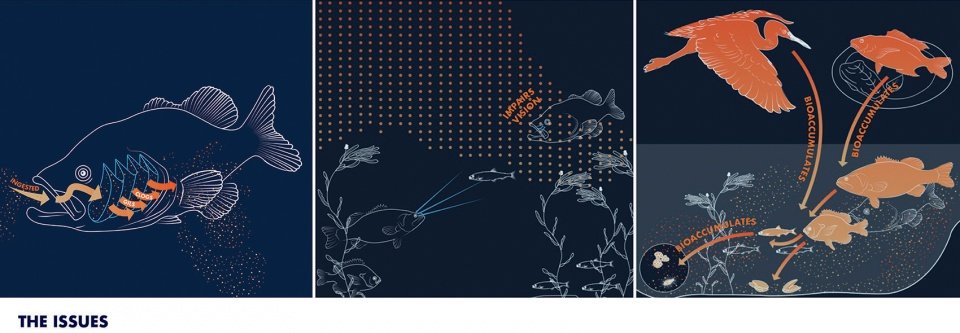
▲生境破坏:污染物被鱼类摄入后,会堵塞其鳃部。污染物损害水质,将影响鱼类的狩猎能力。污染物在水生生物中进行生物积累,还将影响到食用这些生物的陆生动物以及人类。Habitat Impairments. Pollutants are ingested by fish clogging their gills. Pollutants impair water quality impacting ability for fish to hunt. Pollutants bioaccumulate within aquatic life and impact terrestrial animals and humans who consume these organisms.©Halina Steiner and Avee Oabel
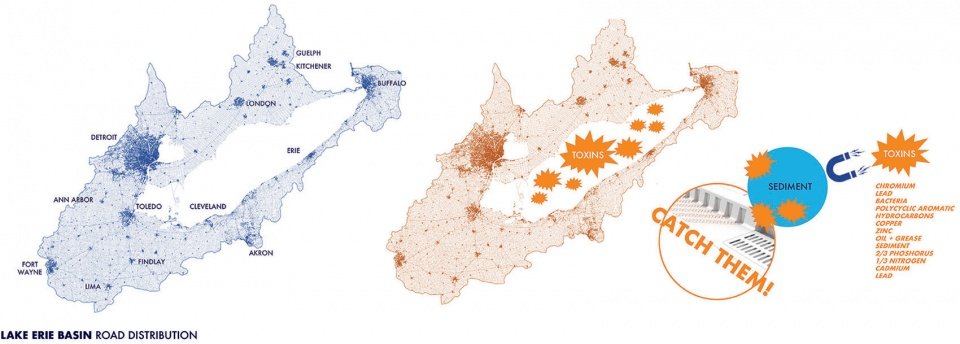
▲Erie湖流域的道路分布:Erie湖流域内有超过13万英里的道路。许多首次冲刷的有毒物质,如营养物质和金属等,都附着在沉积物上。拦截这些沉积物能够减少水道中的毒素含量。Lake Erie Basin Road Distribution. There are over 130,000 miles of roads within the Lake Erie Basin. Many first flush toxins, like nutrients and metals attach to sediment, if we capture sediment, we can reduce toxins in our waterways.©Halina Steiner
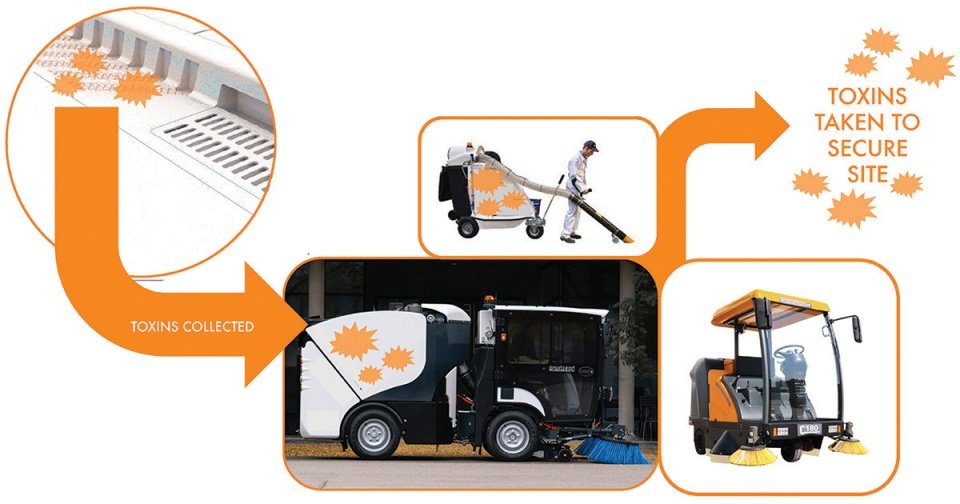
▲潜在的维护:新的路缘石、水沟和集水坪设计可通过现有的街道清洁机来维护。另一种可能是开发新的维护方法和环保的工作计划。Potential Maintenance. Regular maintenance of new curb, gutter, and apron designs can be performed by street cleaning machines already in use, or new maintenance practices coupled with green jobs programs could be developed.©Halina Steiner
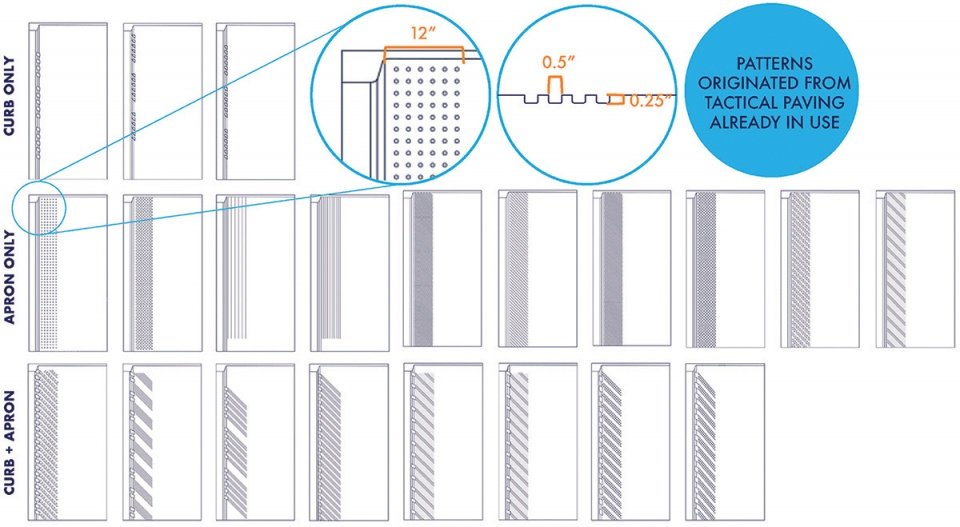
▲被测试的设计:在反复的设计过程后,项目团队对21种路缘石和集水坪的设计标准进行了测试。集水坪从路缘石的表面伸出12英寸,深度为0.25英寸。路缘石和集水坪的设计被分别测试,然后再进行组合。Tested Designs. Twenty-one alternatives to the standard curb and apron were tested via an iterative design process. Apron design extend 12” from the curb face and are a quarter inch deep. Curb and apron designs were tested separately, then combined.©Halina Steiner and Avee Oabel
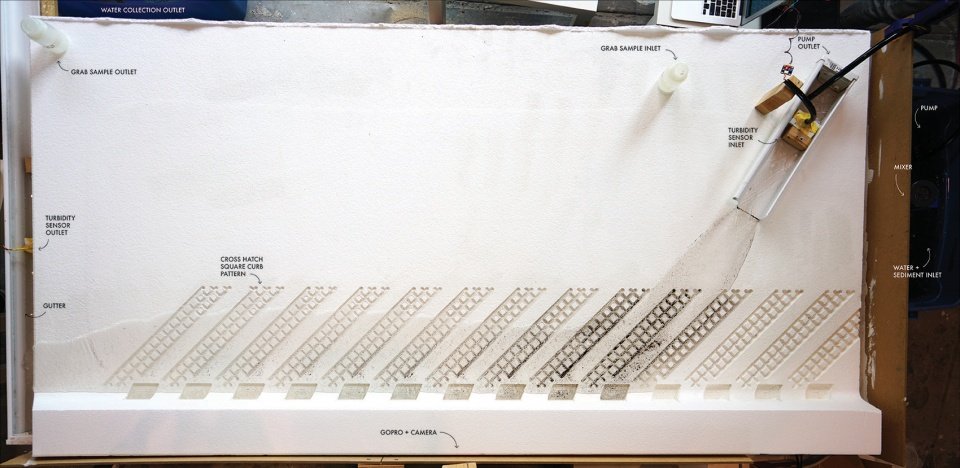
▲测试的配置:物理配置包括一张4’x8’的桌子、乙烯基材质的水沟、4’x8’x8”的EPS泡沫底座,两个31加仑的塑料桶、工业搅拌机、秤、本地土壤、沙子、采样瓶,两个带有模拟浊度传感器的Arduino微控制器、一台iPad、一台GoPro、数台笔记本电脑和一台摄像机。Testing Set-Up. The physical setup included a 4’x8’ table, a vinyl gutter, 4’x8’x8” stock pieces of EPS foam, two 31-gallon plastic tubs, industrial mixer, scale, native soil, sand, sampler bottles, Arduino microcontrollers with analog turbidity sensors, ipad, GoPro, laptops, and a camera.©Halina Steiner
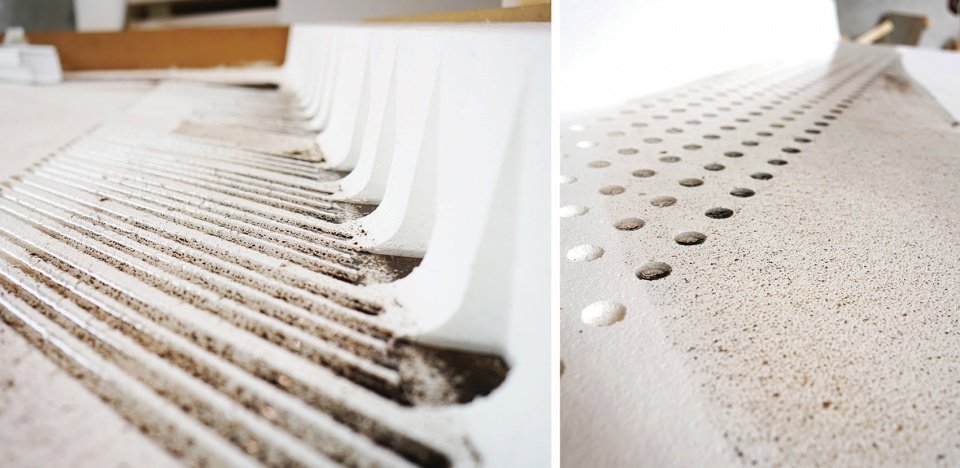
▲测试过程拍摄:照片显示了沉积物聚集在路缘石切口和集水坪的凹陷处。Testing Stills. Images from testing process show sediment collecting in curb cuts and apron depressions.©Halina Steiner

▲方形路缘石和点状集水坪测试:通过第一轮测试的方形路缘石和点状集水坪设计。盲道的铺砖设计为集水坪的图案提供了灵感。在该备选方案中,0.25英寸的凹陷为沉积物提供了空隙,使其以月牙半的形状聚集。Square Curb and Dots Apron Tests. Square Curb and Dots Apron designs after first round of testing. Tactile paving serves as inspiration for Dots patternmaking. In this alternative application, quarter inch depressions provide a void for the sediment to collect in crescent forms.©Halina Steiner

▲锯齿状集水坪测试:与路缘石平行的起伏线条为沉积物创造了高峰和低谷,使其能够从中流过。沉积物聚集在凹陷处,减缓了水的流动。水在高点处时流速加快,使沉积物在表面上聚集成v形图案。Zig Zag Apron Tests. Undulating lines parallel to the curb create peaks and valleys for the sediment to navigate. Sediment gathers in depressions, slowing the flow of water. Water moves swiftly along the peaks arranging the sediment in v shaped patterns on the surface.©Halina Steiner

▲锯齿状和波形集水坪测试:锯齿状图案被调整至朝向路缘石的方向。带角度的波形线首先突出了沉积物在最窄处的汇聚。随着更多带有泥沙的雨水的加入,沉积物的延伸距离也变得更长。 Zig Zag and Squiggle Apron Tests. Zig Zag pattern is reoriented to flow into the curb face. Angled serpentine lines highlight sediment collection at the narrowest point first. As more sediment laden stormwater is added, the sediment collection extends to the longer portion of the pattern.©Halina Steiner

▲路缘石和集水坪测试:继续测试并迭代路缘石和集水坪的密度。Curb and Apron Tests. Continued iteration on apron and curb density.©Halina Steiner
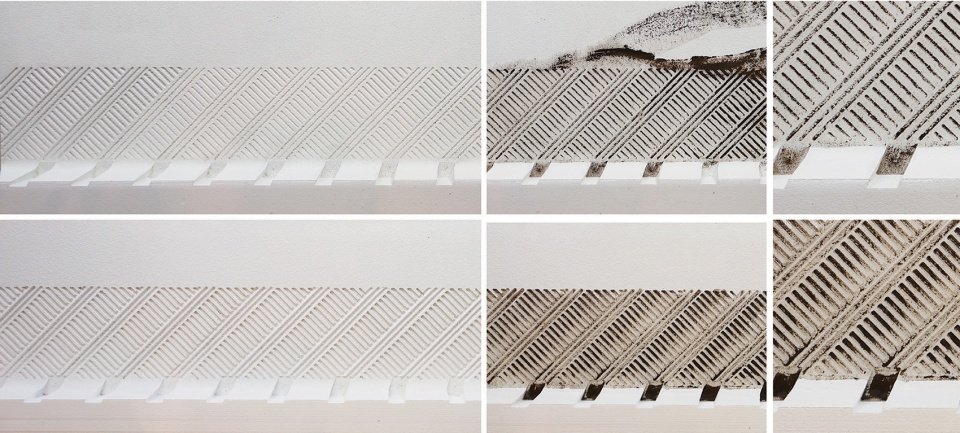
▲平行+垂直线图案(上)和梳齿状图案(下):经过重新设计,平行+垂直线图案的集水坪被改为梳状图案。三条较长的直线连接至路缘石的切口,同时与中间的平行短线贯通,看上去就像是梳齿。Parallel and Perpendicular (above) and Comb (below) Patterns. Parallel and Perpendicular lines fill the apron. A reworked Parallel and Perpendicular pattern evolves to the Comb. Three long lines connect to curb cuts and connect to the shorter lines that run parallel, like the teeth of a comb.©Halina Steiner
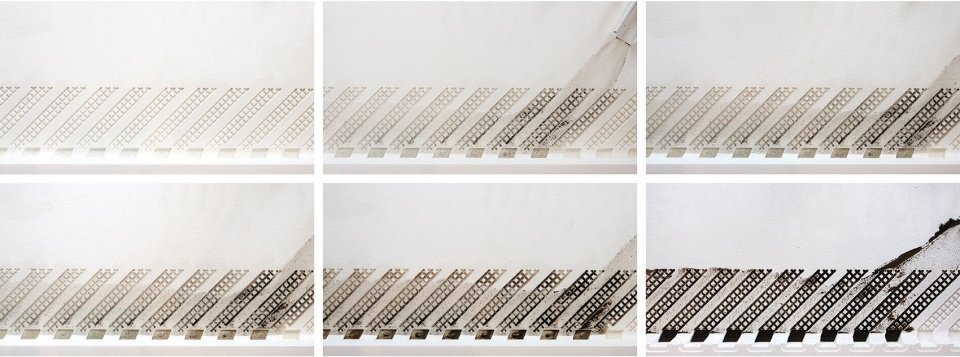
▲格子图案路缘石测试:在整个测试过程中,格子图案的路缘石设计可令沉积物首先聚集在集水坪,随后再充满路缘石的切口。Cross Hatch Curb Connect Testing Stills. Cross Hatch Curb Connect pattern stills throughout the testing process show sediment collection first at the apron and later filling the curb cuts.©Halina Steiner
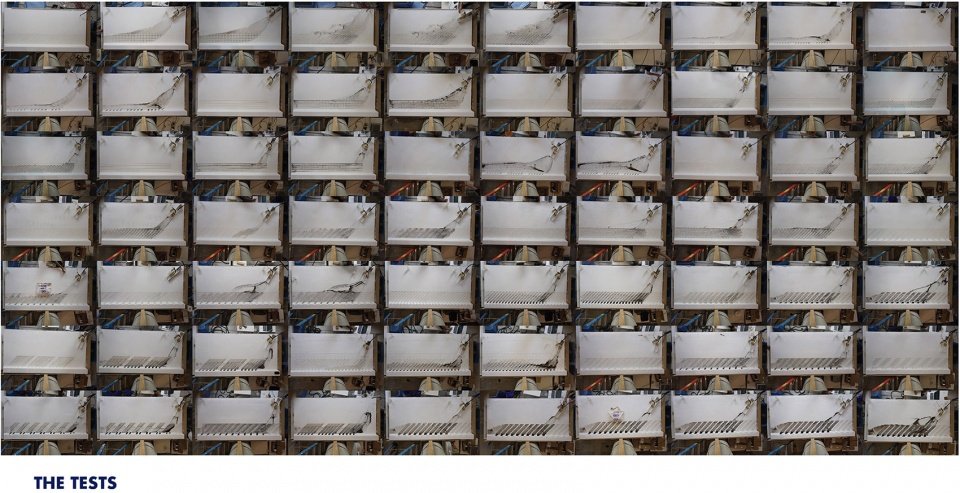
▲测试照片:每轮测试持续8分钟。这里显示的是测试前后的静态照片。Testing Stills. Still before and after images from each round of eight minute tests.©Halina Steiner
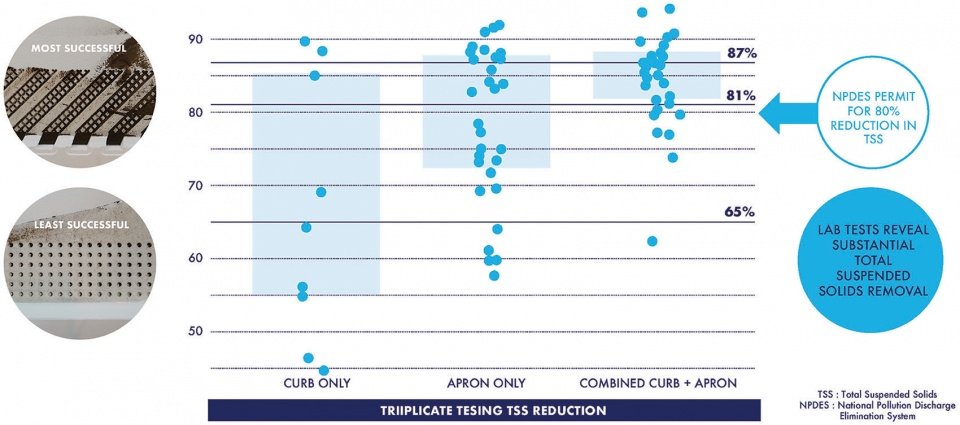
▲测试结果:抓样数据处理显示,多个设计符合或超过了EPAs NPDES标准,有望成为最佳管理实践方案。路缘石和集水坪的组合设计平均能够去除87%的总悬浮固体。Testing Results. Grab sample data was processing revealed that many of the designs met or exceeded the EPAs NPDES criteria to become a best management practice. The combined curb and apron designs removed an average 87% Total Suspended Solids.©Halina Steiner
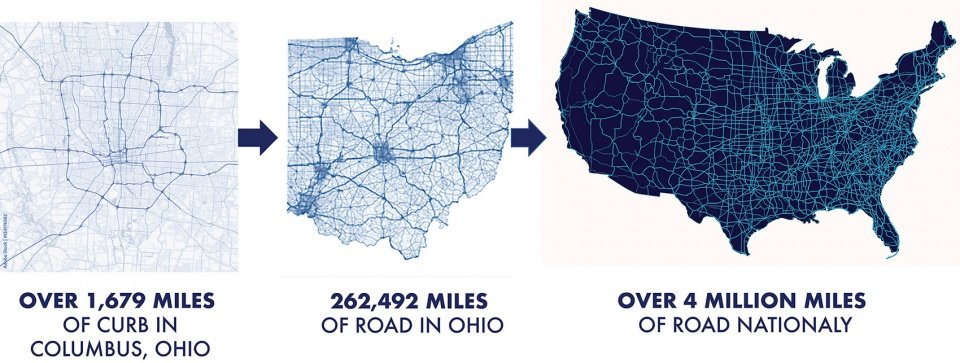
▲“遏制沉积物”的潜在可扩展应用:根据联邦公路管理局的数据,美国有超过400万英里的道路。这一重要的基础设施像磁铁一般吸引并输送了大量的污染物。设计标准的小规模改变也可以产生区域性乃至全国性的影响。Curbing Sediment Potential Scalable Application. According to the Federal Highway Administration, there are over 4 million miles of road in the United States. This critical infrastructure is a magnet and superhighway for pollutants. Small scale changes in design standards can have regional and national impacts.©Halina Steiner
Project Narrative
BACKGROUND
A curb is a simple but ubiquitous thing. San Francisco, for instance, has approximately 275,000 curbside parking spaces, just shy of 5 million linear feet of curb. The operation of a curb, gutter, and apron is transparent; they facilitate the movement of storm-water from the road to a storm drain (and then to a sewer) or, more recently, a bioswale. However, this straightforward gesture carries more than only water. First flush toxins and sediment accumulation on the road and during storm events are transported with the water along the gutter at the curbs base. Stormwater runoff transports pollutants including sediment, nutrients from lawn fertilizers, bacteria, pesticides, metals, and petroleum by-products often discharging to waterways, often without treatment. Once in the waterway, similar to microplastics, removal of the pollutants is challenging. A typical curb and gutter is designed for conveyance of stormwater only, and so it does not provide any water quality benefit. Can we challenge conventional design standards, like the curb, to do more? With the widespread use of curbs, small-scale changes have the ability to have regional impacts. As we improve design standards to increase functionality, can their design communicate complex relationships that exist between our cities and the environments they impact? If we can design a better curb, one that collects pollutants before they enter the waterway, we can improve the health of our watersheds.
TESTING
Full-scale mock roads with custom curb and gutter designs were fabricated using EPS foam, curb profiles were made via a hot wire cutter, and designs milled via CNC router. The physical setup and materials included a 4’x8’ table with a vinyl gutter attached to one end, 4’x8’x8” stock pieces of EPS foam, two 31-gallon plastic tubs, an industrial mixer, scale, native soil, sand, sampler bottles, two Arduino microcontrollers with analog turbidity sensors, an ipad, GoPro, three laptops, and a camera. Milled and sealed foam pieces were placed on the platform with the GoPro Hero 6 and Sony a7RII suspended above them. The GoPro recorded video of the tests and the camera took still images every 10 seconds. Testing began with weighing approximately 70-80 kg of water into the 117 liter tote plastic tubs. A mixture of roughly 60-70% native soil and 30-40% sand was added to the water to simulate stormwater. The mixer dispersed the soil and sand mixture uniformly in the tub, ensuring simulated stormwater concentrations were consistent throughout the simulated storm event. A submersible pump, placed at the bottom of the tub, conveyed the water onto the surface of the model. A turbidity sensor was placed to gather data at the pumped simulated stormwater inlet. Simulated stormwater moved freely over the surface of the model during each 8-minute test. The water then flowed into a gutter where the second sensor was located and finally into the outlet tub. Outlet water in the tub was weighted as well as any remaining water in the inlet tub. During the tests grab samples were taken at the inlet and outlet at 2-minute intervals.
Twenty-one curb, gutter, and apron designs were tested. Each design was tested in triplicate in succession. Sediment from each test was left on the model’s surface to determine how much sediment each design could effectively hold. The three most successful designs received 1-7 rounds of additional tested storm events each with increased volumes of sediment added to determine failure modes and timing.
FINDINGS
Data were collected via three means. Visual data was collected with the camera, GoPro, and by the team as the tests ran. Additionally, the team could visually assess water clarity in grab sample bottles and outlet tub water. Grab samples were tested in the lab for TSS and particle size distribution. Sensor data were reviewed during the tests and further analysis was conducted to compare findings with grab sample data.
Sediment was collected for each design tested. Designs with both a curb and apron modification performed better than designs including only a curb or an apron modification. National Pollution Discharge Elimination System (NPDES) stormwater permits in Ohio require an 80% reduction in total suspended solids (TSS) for stormwater management. Six of the eight combined curb and gutter designs met or exceeded 80% reduction in TSS.
CONCLUSION
Prototype testing of 21 designs proved redesigning curb, gutter, and apron standards can be a viable option to collect pollutants on roadways. These new designs can be used in concert with green infrastructure to reduce clogging or independently on roadways. Curbing Sediment’s small footprint can be advantageous in areas with mature trees and narrow sidewalks. Custom patterns could be developed for Business Improvement Districts or by municipalities to adapt to specific aesthetic, hydrologic, and/or other physical conditions. Regular maintenance of curb, gutter, and apron designs can be performed by street cleaning machines already in use.
This proof of concept research suggests Curbing Sediment is a feasible alternative to the standard curb, gutter, and apron design. However, testing in a controlled environment has its limits. The next phase of design will include field testing. The research team has received provisional patents for the designs and is currently identifying sites and funding for prototype pilot projects. Innovations such as bioswales have proven that small site scale interventions deployed at a regional scale can improve water quality. Curbing Sediment leverages the design standard to question current design practices, can each element do more? Small-scale changes in design standards can have regional and potentially national impacts.
More:ASLA;Halina Steiner;Ryan Winston


